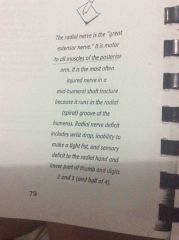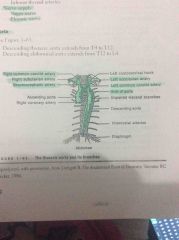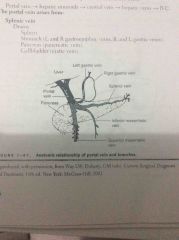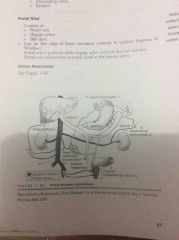![]()
![]()
![]()
Use LEFT and RIGHT arrow keys to navigate between flashcards;
Use UP and DOWN arrow keys to flip the card;
H to show hint;
A reads text to speech;
109 Cards in this Set
- Front
- Back
|
C shaped |
Tracheal rings |
|
|
Lining of trachea |
Respiratory epithelium: pseudostratified columnar with mucous secreting goblet cellsit supplies the up |
|
|
Blood supply for the upper extremities |
Subclavian artery |
|
|
Axillary artery passed at what rib |
First rib |
|
|
Brachial artery is a continuation of |
Axillary artery |
|
|
It results from the compression of the lower of the brachialplexus and the subclavian artery between the anterior and middle scalene |
Thoracic outlet syndrome |
|
|
Brachial plexus innervates |
Shoulder girdle and upper limb |
|
|
Pinky finger is supplied by what nerve |
Ulnar nerve |
|
|
Great extensor nerve |

|
|
|
It is called the nerve of bell |
Long thoracic nerve |
|
|
ROTATOR CUFF MUSCLES |
SITS! supeaspinatus- abduction Infrasoinatus- external rotation Teres minor- ext rotation Subscapularis- internal rotation |
|
|
Ribs that articulate directly with sternum |
Upper seven ribs
Manubriun- clavicle and 1st rib Body- rib2-7 Xiphoid process |
|
|
Ribs that articulate directly with sternum |
Upper seven ribs
Manubrium- clavicle and 1st rib Body- rib2-7 Xiphoid process |
|
|
Also called suprasternal notch |
Jugular notch |
|
|
Articulation of manubrium and body at second rib Manubriosternal joint |
Angle pf louis |
|
|
True ribs False ribs Floating ribs |
1-7 8-10 11-12 |
|
|
What are the muscles of respiration |
Diaphragm- main ms for breathing Intercoatals Accessory ms |
|
|
Suspensory ligaments are also called |
Cooper's ligaments |
|
|
Location of pulmonary artery in relation to bronchus |
RALS Right Anterior Leftsuperior |
|
|
Which lung has lingula |
Superior lobe of left lung |
|
|
Blood vessel that has the lowest blood pressure |
Vena Cava |
|
|
Location of SA node |
Superior portion of right atrium Also called Crista terminalis |
|
|
Blood vessel that has the lowest blood pressure |
Vena Cava |
|
|
Location of SA node |
Superior portion of right atrium Also called Crista terminalis |
|
|
Pacemaker of the heart |
SA node |
|
|
2 types of circulation |
Pulmonary and systemic circulation |
|
|
Pulmonary circulation |
Vena cava-> Right atrium-> tricuspid valve-> right ventricle-> pulmonary semilunar valve-> pulmonary artery-> lungs |
|
|
Systemic circulation |
Lungs-> pulmonary vein-> left atrium-> bicuspid valve/mitral valve-> aortic semilunar valve-> Aorta-> systemic circulation |
|
|
In what intercostal space is the aortic and pulmonic valve located |
2nd intercostal space at the right sternal border |
|
|
In what intercostal space is the tricuspid valve and mitral valve located |
Over left sternal border at 5th intercostal space |
|
|
Vertical groove on external heart that represents crista terminalis internally |
Sulcus terminalis |
|
|
Conduction system of the heart |
SA and AV node |
|
|
Pumps deoxygenated blood thru the pulmonic valve to pulmonary artery and lungs for oxygenation |
Right ventricle |
|
|
At what intercostal space is the apex of the heart located |
5th intercostal space |
|
|
At what intercostal space is the apex of the heart located |
5th intercostal space |
|
|
Responsible for pulmonic circulation
Responsible for systemic circulation |
Right ventricle Left ventricle |
|
|
What innervates pericardium? |
Phrenic nerve |
|
|
First branches of aorta |
Coronary arteries |
|
|
All veins of the heart drain into ____ |
Coronary sinus except ANTERIOR CARDIAC VEINS(drain directly to right atrium) |
|
|
Area medial to the lungs in the thorax |
Mediastinum |
|
|
Thymus is located in both anterior and posterior mediastinum (true or false) |
True
*thymus has no afferent lymphatics or lymphatic nodules |
|
|
It is the most important element for immunity (involved in all aspects of immunity) |
Zinc |
|
|
Aorta |

Thoracic aorta and its branches |
|
|
Backflow at the right atrium up to the liver causes |
Nutmeg liver |
|
|
Edema of the stomach |
Ascites |
|
|
Major branches of the aortic arch |
Brachiocephalic artery Left common carotid artery Left subclavian artery
*aortic arch supplies head, neck and upper limbs |
|
|
Common carotid artery supplies |
Head and neck |
|
|
Common carotid artery supplies |
Head and neck |
|
|
Subclavian artery supplies |
Upper extremities |
|
|
Branches of subclavian artery |
Vertebral (forms basilar- circle of willis) Thyrocervical Internal thoracic Costocervical |
|
|
The right superior intercostal vein drains into the _____
The left superior intercostal vein drains into the _____ |
Azgos vein Brachiocephalic vein |
|
|
this is formed by left and right brachicephalic veins ( merging int he superior mediastinum) |
Superior vena cava ( no valve) |
|
|
this is formed by left and right brachicephalic veins ( merging int he superior mediastinum) |
Superior vena cava ( no valve) |
|
|
Brachiocephalic veins are formed from |
Internal jugular vein and subclavian vein |
|
|
this is formed by left and right brachiocephalic veins ( merging into the superior mediastinum) |
Superior vena cava ( no valve) |
|
|
Brachiocephalic veins are formed from |
Internal jugular vein and subclavian vein |
|
|
Azygos vein empties into the
While superior vena cava empties into |
Superior vena cava
Right atrium |
|
|
Inferior vena cava |
Rudimentary/nonfunctional valve Drains: thorax abdomen and lower extremities Receives blood from hepatic veins Empties into the Right atrium |
|
|
Paired branches of INferior vena cava |
Suprarenal Renal Gonadal Lumbar |
|
|
Transmits venous blood from abdominal viscera (with absorbed substances to the liver and via the portal system to the heart) |

Portal vein - arises from splenic and superior mesenteric vein |
|
|
Superior mesenteric vein drains |
Small intestine Cecum Ascending and transverse colon |
|
|
Inferior mesenteric vein drains |
Transverse colon distal to L colic flexure (splenic flexure) Descending colon Rectum |
|
|
Portal triad consists of: |
Portal vein Hepatic artery Bile duct |
|
|
Portal triad consists of: |

Portal vein Hepatic artery Bile duct |
|
|
Cisterna chyli drains lymph from |
Lower limbs Abdomen Chest wall |
|
|
Duct of lymphatic system that empties into venous system at junction of the subclavian and internal jugular vein(on the left side only) |
Thoracic duct - drains lymph from lower limbs abdomen and chest wall |
|
|
Duct of lymphatic system that empties into the junction of right internal jugular vein and right subclavian vein( formation of the brachiocephalic vein) |
Right lymphatic duct - drains right arm right side of chest and right side of head |
|
|
Aside from the right arm, chest and right head- the rest of the body is drained by |
the thoracic duct( left lymphatic duct) |
|
|
Membrane lining the interior of the abdominopelvic cavity |
Peritoneum |
|
|
Outlet of stomach to duodenum |
Sphincters |
|
|
Outlet of stomach to duodenum |
Sphincters |
|
|
Also called crura of diaphragm |
External sphincter |
|
|
Organ that serves as blood reservoir and produce mononuclear leukocytes |
Spleen |
|
|
Organ that serves as blood reservoir and produce mononuclear leukocytes |
Spleen |
|
|
Stores and concentrates bile |
Gall bladder |
|
|
Organ that serves as blood reservoir and produce mononuclear leukocytes |
Spleen |
|
|
Stores and concentrates bile |
Gall bladder |
|
|
Common bile suct is formes by |
Cystic duct (from gall bladder) Hepatic duct ( from liver) |
|
|
Common bile suct is formed by |
Cystic duct (from gall bladder) Hepatic duct ( from liver) |
|
|
Common bile duct is formes by |
Cystic duct (from gall bladder) Hepatic duct ( from liver) |
|
|
Sphincter of odi is also called? |
Ampulla of vater |
|
|
If sphinter of oddi relaxes |
-Gallbladder contracts -Bile released into duodenum for fat emulsion -Cholecystokinin; fat into intestine |
|
|
Shape of duodenum |
C shaped
It is also the shortest and widest part of small intestine |
|
|
Contains brunners gland(submucosal glands) secreting mucous |
Duodenum |
|
|
Where can you found Valves of kerckring or plicae circulares |
Jejunum ( has the most villu for greatest absorption) Thickest muscular wall |
|
|
Where can you find peyer's patches |
Ileum - absorbed bile and b12 - more goblet cells and mesenteric fat than jejunum |
|
|
Enzyme that converts trypsinogen to trypsin |
Enterokinase
Trypsin activates other pancreatic enzymes |
|
|
Site of fluid and electrolyte reabsorption |
Large intestine |
|
|
Site of fluid and electrolyte reabsorption |
Large intestine - does not secrete enzymes |
|
|
"Blind sac" |
Cecum |
|
|
3 smooth muscle bands in the colon |
Teniae coli
Haustra- pouches created by teniae |
|
|
These are fat globules on serosal surface of colon |
Epiploic appendages |
|
|
Opening of duodenum |
Ampulla of vater |
|
|
These are non encapsulated lymphoid tissue in ileum |
Peyers patches |
|
|
Lies in the C concavity (curve) of duodenum |
Pancreas |
|
|
Major pancreatic duct Accessory pancreatic duct |
Duct of wirsung- begins at tail and joing common bile tonform ampulla of vater Santorini's duct- opens separately into duodenum |
|
|
Located in adipose tissue on superior aspect of kidneys |
Adrenal gland |
|
|
Bile and pancreatic enzymes are released at _____ |
Ampulla of vater into second part of duodenum |
|
|
Neural crest cells differentiate into _______ |
Medullary cells/chromaffin cells |
|
|
Neural crest cells differentiate into _______ |
Medullary cells/chromaffin cells |
|
|
Adrenal medulla releases |
Epinephrine Norepinephrine |
|
|
Lining of urinary system |
Transitional epithelium |
|
|
Kidney is protected by what ribs |
Rib 11& 12 |
|
|
Size of urethra in female and male |
4cm- female prone to infections 20cm |
|
|
Suspends the testes within the scrotum |
Spermatic cord |
|
|
Suspends the testes within the scrotum |
Spermatic cord |
|
|
Inguinal canal is larger in males than in females true or false |
True |
|
|
Conveys epididymis from testis to ejaculatory duct |
Ductus(vas) deferens |
|
|
Attaches falx cerebri |
Crista galli |

